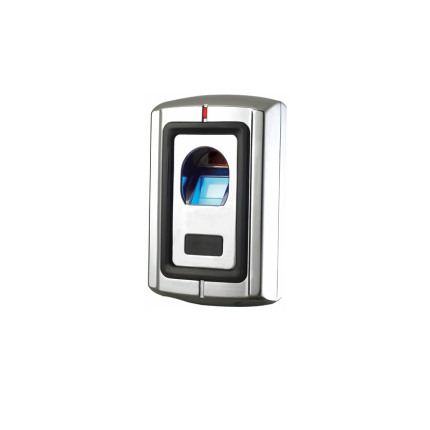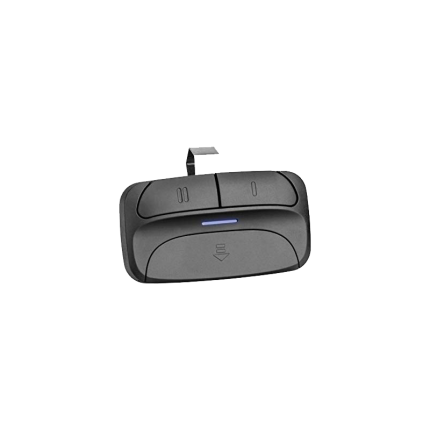Shop
Fingerprint Access Control
Ship or pick up from our office.
Fingerprint Access Control
A fingerprint access control system is a security system that uses an individual's unique fingerprint to grant or deny access to a physical space (like a building or a room) or a digital system. It's a type of biometric access control, which relies on distinct biological traits for identification. How it Works The process generally involves two main steps:- Enrollment: When a user is first set up in the system, a fingerprint scanner captures an image of their fingerprint. This image is then converted into a digital template (a mathematical code, not an actual image) and securely stored in a database. This template represents the unique characteristics of that person's fingerprint, such as ridge endings and bifurcations.
- Verification: When someone tries to gain access, they place their finger on the scanner again. The system captures a new image, converts it into a template, and then compares it to the stored template in the database. If there's a match, access is granted; otherwise, it's denied. This entire process is typically very fast.
- Fingerprint Reader/Scanner: The device that captures the fingerprint image.
- Communication Network: To transmit the captured data to the database.
- Database: Where the digital fingerprint templates are stored.
- Management Software: For administering users, permissions, and logging access events.
- Electronic Door Locks: Locks that are controlled by the system, opening when access is granted.
- Power Supply: To power all the system components.
- Enhanced Security: Fingerprints are unique to each individual and are extremely difficult to replicate or steal, making them more secure than traditional keys, cards, or PINs.
- Convenience: Users don't need to carry keys or remember codes, as their fingerprint is always with them.
- Improved Accountability: Every access event is tied to a specific individual, creating clear and accurate audit trails.
- Reduced Risk of Lost/Stolen Credentials: There are no physical keys or cards to be lost, stolen, or shared.
- Cost-Effective in the Long Run: While there might be an initial investment, it can save money by eliminating the need for replacing lost cards or rekeying locks.
- Physical Contact Required: Most fingerprint scanners require direct contact, which can be a hygiene concern and may not work if fingers are dirty, wet, or injured.
- Potential for Recognition Issues: Scars, calluses, or even minor cuts can sometimes make it difficult for the system to recognize a fingerprint, leading to false rejections.
- Enrollment Time: Registering each user's fingerprint can be time-consuming in large organizations.
- Spoofing Concerns: While difficult, advanced techniques could potentially "spoof" a fingerprint. Modern systems often include "liveness detection" to counter this.
- Not Ideal for Visitors: It's not practical to enroll temporary visitors for short-term access.
- Optical Scanners: Capture a visual image of the fingerprint using light.
- Capacitive Scanners: Use electrical current to create an image of the fingerprint's ridges and valleys.
- Ultrasonic Scanners: Use sound waves to create a 3D map of the fingerprint.
- Thermal Scanners: Detect temperature differences between the ridges and valleys.
- Touchless Fingerprint Readers: Some newer systems allow for contactless scanning, often using 3D imaging of multiple fingers.
Garage Door Opener Remote Control
Ship or pick up from our office.
Garage Door Opener Remote Control
A garage door opener remote control is a small, handheld device that uses radio frequency (RF) signals to wirelessly communicate with your garage door opener system. Essentially, it's a transmitter that sends a unique code to a receiver built into your garage door motor unit, telling it to open or close the garage door. Here's a breakdown of how it works and its key features: Functionality:- Signal Transmission: When you press a button on the remote, it sends a radio frequency signal containing a specific code.
- Signal Reception: The garage door opener has a receiver that constantly "listens" for these signals.
- Code Matching: If the received code matches the opener's stored code, the receiver activates the motor.
- Motor Activation: The motor then powers a drive mechanism (chain, belt, screw, or direct drive) that moves the garage door up or down.
- Radio Frequency (RF) Communication: Most remotes operate using RF signals (commonly 315 MHz or 390 MHz), allowing them to work from a distance and even through walls.
- Fixed Code Technology (Older): Early remotes used a fixed code that was sent every time. This was less secure as the signal could be easily intercepted and duplicated.
- Rolling Code Technology (Modern): To improve security, modern remotes use rolling code technology. The code changes every time you press the button, making it extremely difficult for unauthorized individuals to "grab" and reuse the code. Brands like LiftMaster (Security+ / Security+ 2.0) and Genie (Intellicode®) use their own versions of this.
- Dip Switches (Older): Some older remotes used physical dip switches that needed to be manually set to match the receiver's code.
- Wi-Fi and Smart Home Integration: Many newer garage door openers feature built-in Wi-Fi, allowing you to control your garage door from anywhere using a smartphone app (e.g., MyQ for LiftMaster/Chamberlain, Aladdin Connect for Genie). These apps often offer additional features like real-time notifications, scheduling, and access history.
- Multi-Button Remotes: Some remotes have multiple buttons, allowing you to control several garage doors or even other devices like lights.
- Universal Remotes: These are programmable remotes designed to be compatible with various brands and models of garage door openers, reducing the need for multiple remotes.
- Standard Remotes: Basic remotes with one or more buttons to operate the garage door.
- Visor Remotes: Larger remotes designed to clip onto your car's sun visor for easy access while driving.
- Keychain Remotes: Small, compact remotes that can be attached to your keyring for portability.
- Keypad Remotes: Mounted outside your garage door, these allow you to enter a numerical code to open the door, useful for keyless entry.
Garden LED Light -Key Automation ST100
Ship or pick up from our office.
Garden LED Light -Key Automation ST100
TECHNICAL FEATURES
| Voltage | Vdc | 24-35 |
| Nominal power | W | 16 |
| Appliance isolation class | III | |
| Degree of protection | IP | 54 |
| Dimensions (L - D - H) | mm | 80 - 80 - 1000 |
| Item | kg | 4,8 |
| Minimum operating temperature | °C | -20 |
| Max operating temperature | °C | +55 |
Garden LED Light -Key Automation ST60
Ship or pick up from our office.
Garden LED Light -Key Automation ST60
TECHNICAL FEATURES
| Voltage | Vdc | 24-35 |
| Nominal power | W | 8 |
| Appliance isolation class | III | |
| Degree of protection | IP | 54 |
| Dimensions (L - D - H) | mm | 80 - 80 - 600 |
| Item | kg | 3,2 |
| Minimum operating temperature | °C | -20 |
| Max operating temperature | °C | +55 |
Garden LED Light -Key Automation STIKDC
Ship or pick up from our office.
PRODUCT SHEET PDFGarden LED Light -Key Automation STIKDC
*Garden lights with a height of 40 cm with front light *Completely made of aluminum *Replaceable LED *Power: 24-35 V/DC - 2W *Body color: Corten *LED color: 4400K/132lm *Height: 404 mm *Version: Ground facing *International Protection Rating: IP 54Garden LED Light -Key Automation STIKFD
Ship or pick up from our office.
Garden LED Light -Key Automation STIKFD
PRODUCT SHEET PDF *Step lights, garage doors, and pergola lights *Completely made of aluminum *Power: 24-35 V/DC - 2W *Body color: Grey *LED color: 4400K/132lm *Length: 240 mm *Version: Flat *International Protection Rating: IP 54Garden LED Light -Key Automation STIKMW
Ship or pick up from our office.
PRODUCT SHEET PDFGarden LED Light -Key Automation STIKMW
*Garden lights with a height of 75 cm with front light *Completely made of aluminum *Replaceable LED *Power: 24-35 V/DC - 2W *Body color: White *LED color: 4400K/132lm *Height: 750 mm *Version: Ground facing *International Protection Rating: IP 54Garden LED Light -Key Automation STIKVC
Ship or pick up from our office.
PRODUCT SHEET PDFGarden LED Light -Key Automation STIKVC
*Lights for pedestrian or vehicular premises are to be installed on top of the fence *Completely made of aluminum *Replaceable LED *Power: 24-35 V/DC - 2W *Body color: Corten *LED color: 4400K/132lm *Height: 246 mm *Version: Vertical face *International Protection Rating: IP 54Garden LED Light -Key Automation TN103N
Ship or pick up from our office.
PRODUCT SHEET PDFGarden LED Light -Key Automation TN103N
TECHNICAL FEATURES
| Duty cycle percentage | % | 100 |
| Voltage | Vdc | 11-26 |
| Nominal power | W | 3 |
| Color rendering index (CRI) | 80 | |
| Degree of protection | IP | 67 |
| Dimensions (L - D - H) | mm | 110 - 110 - 90 |
| Item | kg | 0,4 |
| Minimum operating temperature | °C | -20 |
| Max operating temperature | °C | +55 |
Garden LED Light Main Control -Key Automation BOXLED
Ship or pick up from our office.
PRODUCT SHEET PDFGarden LED Light Main Control -Key Automation BOXLED
*Light for installation in gardens, hotels, and residential areas *Completely waterproof *Conceived for the automatic control of LED lights *Output for night sensor QUADRO *Built-in receiver 433 MHz (up to 30 stored codes) *Programming with buttons or via display DYL *Power supply: 90-260 V/AC *4 independent outputs to control up to 8 lights each (32 lights total)Gate drop ground latch
Ship or pick up from our office.
Gate drop ground latch
A gate drop ground latch, also known as a cane bolt or drop rod, is a hardware mechanism used to secure a gate in either the open or closed position by inserting a rod into the ground.
It's commonly used for single or double gates, including wooden fences, metal gates, and even barn doors, to provide extra stability and prevent unwanted movement.
Here's a more detailed explanation:
How it works:
- The latch typically consists of a rod (the "drop rod" or "cane bolt") and a bracket or receiver that is mounted on the gate.
- When the gate is in the desired position (open or closed), the rod is manually lowered through the bracket and into a hole or receiver in the ground.
- This creates a secure hold, preventing the gate from swinging or being moved by wind or other forces.
- Some designs include a bracket or keeper to hold the rod in the raised (open) position when not in use.
Common uses:
- Securing single or double gates: The drop ground latch can be used on both types of gates to keep them firmly in place.
- Providing stability in windy conditions: It helps prevent gates from being blown open or closed by the wind.
- Securing gates in the open position: It can be used to hold a gate open, preventing it from accidentally closing.
- Reinforcing gate security: It adds an extra layer of security, making it more difficult to force the gate open.
- Suitable for various materials: Can be used with wood, metal, and other gate materials.
Benefits:
- Enhanced security: Prevents gates from being moved by wind or other forces.
- Increased stability: Helps keep gates aligned and prevents sagging.
- Versatile application: Can be used on a variety of gates and in different environments.
- Easy to operate: Simple manual operation to engage and disengage the latch.
- Relatively easy to install: Usually requires drilling holes for mounting the brackets.



















